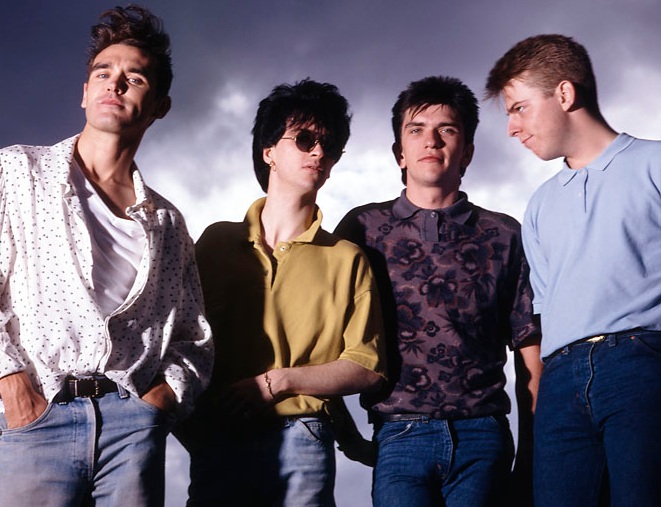The Smiths, one of the most influential bands to emerge from the British indie music scene, were formed in 1982 in Manchester, England. The band’s lineup consisted of the enigmatic lead singer Morrissey, the innovative guitarist Johnny Marr, the steadfast bassist Andy Rourke, and the dynamic drummer Mike Joyce. The genesis of the band is a tale of serendipity and shared vision, where the artistic aspirations of its members converged to create an enduring musical legacy.
Morrissey and Marr’s partnership was the cornerstone of The Smiths’ creative output. Morrissey’s introspective and often melancholic lyrics, paired with Marr’s jangly guitar riffs, created a sound that stood out in the early 1980s. During this period, the musical landscape was dominated by synth-pop and post-punk genres, which made The Smiths’ raw and guitar-driven music all the more distinctive. This divergence from the mainstream was not just a stylistic choice but a cultural statement that resonated deeply with the disaffected youth of the time.

The early 1980s in Manchester was a fertile ground for musical innovation. The city’s industrial backdrop and rich cultural tapestry provided the perfect milieu for The Smiths’ emergence. The band quickly garnered attention with their debut single “Hand in Glove” released in 1983, which received positive reviews from the art press and music essay critics alike. This initial reception hinted at the profound impact The Smiths would soon have on the British music scene.
Their music, characterized by its lyrical depth and melodic complexity, struck a chord with a generation seeking authenticity and emotional resonance. The Smiths’ influence extended beyond their sound; their aesthetic, characterized by a blend of vintage and contemporary styles, also set them apart. As investigative journalism pieces from the era reveal, the band’s appeal lay in their ability to articulate the anxieties and aspirations of their audience with uncanny precision.
Through their unique blend of poignant lyrics and innovative music, The Smiths not only shaped the indie music scene of their time but also left a lasting cultural imprint that continues to inspire artists and music aficionados today.
The Smiths (1984)
The debut album, “The Smiths,” released in 1984, set the stage for the band’s unique style. With Morrissey’s melancholic vocals and Johnny Marr’s jangly guitar work, the album introduced listeners to the distinctive sound that would characterize The Smiths’ music. Key themes include loneliness, alienation, and social commentary, as evident in standout tracks like “Reel Around the Fountain” and “This Charming Man.” The recording process, marked by the band’s intense collaboration, resulted in a raw yet polished sound. Critics lauded the album for its lyrical depth and innovative musicality, though commercial success was modest compared to later releases.
Meat Is Murder (1985)
Released in 1985, “Meat Is Murder” marked a significant evolution in The Smiths’ musical journey. The album delved deeper into political and social issues, with Morrissey’s lyrics reflecting his staunch anti-meat stance, particularly on the title track. Musically, the band experimented with more varied arrangements, incorporating rockabilly and funk elements. “The Headmaster Ritual” and “That Joke Isn’t Funny Anymore” are notable tracks that highlight this stylistic diversity. The recording process was marked by a more refined production approach, resulting in a cohesive album. Critical reception was generally positive, praising its bold themes, although its commercial impact remained similar to their debut.
The Queen Is Dead (1986)
“The Queen Is Dead,” released in 1986, is often considered The Smiths’ magnum opus. This album encapsulates the band’s creative zenith, blending melancholic lyricism with lush, intricate guitar work. Themes of British identity, love, and despair permeate the album, with iconic tracks like “There Is a Light That Never Goes Out” and “Bigmouth Strikes Again.” The recording process was extensive and meticulous, contributing to its polished and rich sound. Critical acclaim was widespread, with many hailing it as one of the greatest albums of all time. In terms of commercial success, it outperformed their previous works, cementing The Smiths’ legacy in music history.
Strangeways, Here We Come (1987)
The final album, “Strangeways, Here We Come,” released in 1987, showcased a band at the peak of their artistic capabilities, yet on the brink of disbandment. This album diverged from their earlier works, offering a more experimental and somber tone. Key tracks like “Girlfriend in a Coma” and “Last Night I Dreamt That Somebody Loved Me” reflect themes of introspection and existential angst. The recording process was both innovative and fraught with tension, capturing a band in transition. Although critical reception was mixed initially, it has since been reassessed more favorably. Despite moderate commercial success, “Strangeways, Here We Come” remains a poignant conclusion to The Smiths’ influential career.
Achievements and Challenges
The Smiths’ career, though brief, marked a significant era in the landscape of alternative rock music. Formed in Manchester in 1982, the band quickly ascended to prominence with their unique blend of jangly guitars, introspective lyrics, and the melancholic yet charismatic presence of lead singer Morrissey. Their rise to fame was propelled by a series of groundbreaking singles, including “This Charming Man” and “How Soon Is Now?”, which showcased their ability to blend sharp social commentary with catchy, guitar-driven soundscapes.
Their debut album, “The Smiths,” released in 1984, received critical acclaim and solidified their reputation as a formidable force in the music industry. Subsequent albums such as “Meat Is Murder” and “The Queen Is Dead” further cemented their legacy, highlighting their versatility and the depth of their artistic vision. These albums not only performed well commercially but also influenced a generation of musicians, with their sound and style permeating the work of numerous bands that followed.




Memorable live performances, including their iconic shows at the Manchester Apollo and their legendary appearance on “The Old Grey Whistle Test,” contributed to their growing fan base and furthered their status as a live act not to be missed. The Smiths’ ability to connect with their audience through both their recorded music and their live shows played a crucial role in their sustained popularity.
However, the band’s trajectory was not without its challenges. Internal tensions, particularly between Morrissey and guitarist Johnny Marr, plagued their later years. Creative differences, coupled with personal conflicts, created a volatile environment that ultimately led to their breakup in 1987. Despite their relatively short tenure as a band, The Smiths left an indelible mark on the music world, influencing countless artists and maintaining a devoted following long after their dissolution.
The Substance of The Smiths’ Work: Themes and Legacy
The Smiths’ oeuvre stands out for its profound thematic depth and lyrical substance, a testament to the collaborative synergy between Morrissey and Johnny Marr. Morrissey’s lyrics are imbued with a sense of alienation and introspection, often reflecting on themes such as love, social issues, and the human condition. His poetic musings on unrequited love and the frailties of human relationships resonate deeply, striking a chord with listeners who find solace or solidarity in his words.
Alienation and a yearning for connection are recurrent motifs in songs like “How Soon Is Now?” and “There Is a Light That Never Goes Out.” Morrissey’s portrayal of social issues, such as in “The Headmaster Ritual,” which critiques the brutality of the British educational system, showcases his keen observational prowess and willingness to confront uncomfortable truths. These themes are not isolated but interwoven into the fabric of The Smiths’ music, creating a rich tapestry of thought-provoking content.


Complementing Morrissey’s lyrical acumen is Johnny Marr’s innovative guitar work. Marr’s jangly guitar riffs and intricate melodies provided a distinctive sonic backdrop that elevated The Smiths’ music beyond the conventional boundaries of rock. His ability to blend traditional rock elements with a modern twist gave The Smiths a unique sound that continues to influence musicians across genres. Marr’s guitar, paired with Morrissey’s voice, created a synergy that defined the band’s distinctive style.
The legacy of The Smiths remains potent even decades after their disbandment. Their influence is evident in the music of countless indie rock and alternative bands, who draw inspiration from The Smiths’ introspective lyrics and innovative sound. Culturally, The Smiths have left an indelible mark, contributing to the broader dialogue on social and personal issues through their music. The enduring appeal of their work is a testament to its timelessness; songs that tackled the challenges of the human condition continue to resonate with new generations of listeners, proving the lasting relevance of The Smiths in today’s musical landscape.









